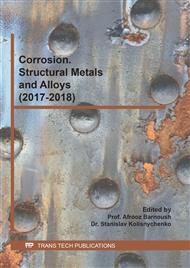p.1698
p.1705
p.1710
p.1716
p.1722
p.1728
p.1734
p.1743
p.1748
Mechanical Fields on Cross-Shaped Specimens for Stress Corrosion Cracking of Cold-Worked Austenitic Stainless Steels
Abstract:
The aim of this work is to better understand the evolution of the mechanical fields in cross-shaped specimens used to study the stress corrosion cracking (SCC) susceptibility of cold-worked stainless steels exposed to the primary water of nuclear power plants. Cross-shaped specimens are used since a loading path change leads to more severe cracking than a monotonous loading. During SCC tests, only the applied load and displacement can be measured as a result of experimental equipment limitations. Therefore, a mechanical test is performed ex-situ under similar condition as the ones applied during the SCC tests. The experimental deformation fields are measured by digital image correlation (DIC) and a numerical model is developed with ABAQUS to calculate the mechanical fields. The obtained results will allow us to calibrate SCC tests already performed but also to know the experimental boundary conditions to apply to reach a given strain value during forthcoming SCC tests.
Info:
Periodical:
Pages:
1722-1727
Citation:
Online since:
December 2018
Authors:
Price:
Сopyright:
© 2018 Trans Tech Publications Ltd. All Rights Reserved
Share:
Citation:



